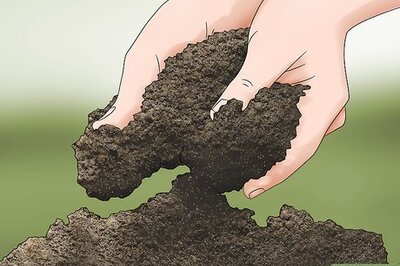
views
Identifying By Appearance
Look out for the key colour patterns on males and females. Male mallards have a glossy green head, the key feature that distinguishes them from other duck species. In addition, they have a drab grey body and brown breast with a white 'collar' around the neck and bright yellow bills. Females are mottled brown in colour with an orange and black bill. Both genders boast a patch of iridescent blue-purple feathers with broad white borders on the wing. This region is known as the speculum, a patch on the secondary flight feathers. This is easily spotted in flight or at rest and distinguishes mallards from other duck species. The brown body colour of females is also more mottled than other duck species such as the American black duck. They have a chestnut-brown chest and a white ring around the neck that is less drab than females of other duck species. However, these two species often interbreed to produce hybrids which share characteristics of both species.
Recognise the distinctive shape of a mallard, both in flight and at rest. They are noticeably large ducks with heavy bodies, rounded heads, and a broad, flat bill. They also share the 'blunt' tail shape of many other surface-feeding ducks, which can be seen riding high out of the water at the end of a long body. When in the air, their wings appear broad and set towards the rear. Mallards have a wingspan of 32–39 inches (81–99 cm), broader than other ducks. This also means that they can reach speeds of up to 55 miles per hour (88 kilometres per hour) in air.
Look out for a duck that is heavier and taller than other duck species. Their bodies make up two thirds of their weight and they can be up to 10 centimetres (3.9 in) taller than a mandarin duck. While much smaller than a Canada goose, it is noticeably larger than other duck species such as teals. Mallards are about 20-26 inches in length (50-65cm), and a mandarin duck is much smaller in comparison, at 16-19 inches (41 to 49cm) long. Look out for an underside that dangles near to the ground - this emphasizes how heavy they are. Mallards are noticeably heavier than other surface-feeding 'dabbling' ducks of a similar shape and build. Look for this weight difference in you are trying to distinguish mallards from other duck species in the same pond.
Recogise the seasonal plumage changes of male mallards. In late summer, drakes shed their iridescent feathers and exhibit a dull, mottled brown colour to provide concealment in their wetland habitats. This feathers eventually grow back in time for the next breeding season, but provide the males with camouflage while they moult. Moulting is a very energetically demanding process that renders the male birds flightless for 3-4 weeks time. During this time, they are more secretive but can be distinguished from female birds by their uniform yellow bill (the female's bill is orange and black) and a more reddish-brown, less well-marked breast.
Recognise the colouration of juvenile mallards. Two months after hatching, young mallards begin to resemble their adult counterparts with a few key differences in colouration: they are a similar speckled brown to the adult female bird, but are darker with more heavily streaked underbellies. The young male also has a brown bill, not a yellow bill like an adult male. Young birds are considered 'juvenile' from 2 months of age until 12-13 months of age. At 6-10 months, male juveniles begin to develop the distinguishing colours of adult birds.
Recognise the feeding mannerisms of the mallard. As a 'dabbling' duck, mallards can be seen feeding on land or 'upending', with their heads in the water and tail sticking up, to feed on plants and aquatic organisms just below the water's surface. A duck diving down frequently is unlikely to be a mallard as they are not adapted to feeding in this way. Mallards often exhibit these feeding behaviours in large groups of dabbling ducks, where food is most abundant, so often you will see a large group of various species 'upending' at once. Congregating in large numbers also reduces risk of predation.
Identifying By Habitat
Look for sheltered areas with water sources. Mallards prefer wetlands near water sources with a huge supply of food and cover. They can be found in many different habitats throughout the country including lakes, rivers, streams, small ponds and marshlands. Keep in mind that many other duck species also share the same habitat preferences.
Look for areas with shallow water depths. Mallards prefer water depths of less than 0.9 metres (3.0 ft) and will avoid going into water that is more than a few metres deep. Some examples of where you can find shallow water are ponds and small lakes/rivers. You can measure how deep water is with a metre stick, or simply by poking a branch into the water and making an educated guess. Mallards can occasionally show up in people's swimming pools or ponds, and putting up a nest structure here can attract a breeding pair.
Recognise nesting sites that could be home to mallards. Mallards nest near water, most frequently in holes in the ground or in trees. Females lay up to twelve eggs with pigments ranging from white to bluish-green. These eggs are usually 5.3–6.4 centimetres (2.1–2.5 in) long. The chicks are a dark chocolate brown colour with a yellow underbelly and a brown marking through their eye. Chicks also exhibit distinguishing behaviours, such as forming an orderly line behind their mother for protection. A little more than a day after birth, mallard chicks can run, swim and forage for food on their own, so the brood may often be sighted swimming alongside their parents. Mallards are highly adaptable birds and so sometimes nest in odd locations in built up areas, such as rooftops, parking lots and near swimming pools. As mallards often live in populated areas, their nests do not only appear in natural bodies of water. Keep an eye on known mallard nesting sites, as they will often return to the same location to nest the following year.
Look out for mallards in areas where food is scattered by the public. Mallards take advantage of food handouts from the public, often congregating into groups with other 'dabbling' (surface feeding) ducks where food thrown by people is floating on the surface of the water. Because of the presence of humans, mallards can often be found in parks in towns or cities.
Look out for their food sources, which may create favourable conditions for them to nest nearby. As well as feeding on aquatic invertebrates, worms and larvae, mallards can also consume plants such as bulrushes and pondweeds, and seeds such as acorns, and wild millet seeds. This means that they are not just found in ponds, but also lakes and wetland areas. Mallards can adapt to almost any diet in an unexpected variety of habitats, including shellfish and berries, so even food sources near drainage dykes and fast flowing rivers could attract a large population.
Study the breeding and overwintering ranges of the mallards. Mallards breed through throughout Europe, the majority of Asia and northern North America. In winter they reach as far south as India, Mexico and North Africa. Migration patterns also vary within continents. For example, within North America, mallards breed in the north, overwinter in the south, and are found year-round in central regions. 'Vagrant' individuals, so-called as they appear well outside their normal range, have been sighted in Central America and the Caribbean.
Consider the time of day, as this also affects mallard behaviour. At night, they forage, flitting between multiple areas of water in search of food. During the day, they group together in a communal roost, socialising through vocalisations, preening, sharing body heat and sleeping in a 'semi-alert' state with one eye open to look out for predators. As opposed to certain other duck species, mallards do not sleep exclusively during the night or day. This can help with the identification of a population depending on how active the group is at particular times.
Identifying By Sound
Listen for the traditional 'quack quack' noise of the females. Mallards are usually associated with this noise, and you are likely to hear a female quack. Male ducks utter one or two reedy notes at a time, but are usually much quieter than their female counterparts. This noise is usually made while the female is floating around in the water. In a group of ducks, it can be hard to tell which duck is making the quacking noise, so try identify the duck by appearance first and then try listening out for their sounds. Females often 'quack' in a set of 2-10 utterances that begins loudly and decreases in volume. When courting, this quack usually comes in pairs.
Listen out for the 'paired' quack of the female mallard during mating season (late winter to early spring), and the short, high-pitched whistles of the males. While females produce two quacks in quick succession, the males can often be heard whistling in courtship displays. Courtship displays by mallards will also help to identify them in the mating season. These bold displays involve rhythmic head-pumping by both males and females. The male's loud whistle is usually accompanied by a 'head-up-tail-up' gesture in which the male pulls up his head and wings to show off his purple-blue feathers beneath. It's often a move made by males in group to 'woo' a female. Males also make a rattling noise by rubbing their bills against their wing feathers in a preening type manner. This noise is aimed towards his mate and is thought to help maintain the pair's bond.
Listen out for the alarm calls of male and female mallards. When danger is present, the female issues a loud, rapid series of quacks that increase in volume. The male alarm call is less vocal and more based on physical display, such as head bobbing or taking flight to signal danger to other ducks. However, they may also produce a low, grumbling sound. The primary function of alarm calls is to warn other ducks in the vicinity of a potential predator or threat. This collective alert system helps enhance the survival chances of the entire group.
Listen out for female ducks 'hailing' other ducks to join them. When alone, female individuals will issue a series of loud, clear quacks that gradually diminish in volume to encourage other mallards flying overhead to join her. This can help guide other individuals to a safe feeding and resting spot, or signal her location to a mate or offspring. Male ducks respond to this decrescendo with a slow, raspy 'raehb' sound. While issuing a hailing call, the female bird often lifts her head high and focuses her attention to the sky to ensure the call is heard by other ducks flying overhead.


















Comments
0 comment